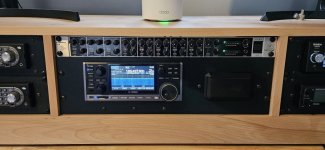Every now and then the issue with the BTL external speaker output of some of Uniden's newer models comes up.
It started with the 536 having only a single external BTL audio external speaker output and no "record" line level output like the earlier base/mobile Uniden receivers had. So people were forced to use the one external speaker output to get their audio into external devices. If the amp were standard single ended relative to ground design this would have been easy but due to the BTL design this caused issues since with a normal two conductor cable you are now shorting one of the tied amplifiers straight to ground (that is bad!) and you get at best some nasty noise and/or distortion and at worst you might just fry one side of the BTL amp (though most modern versions have some protection against this). Presumably this design was carried over to the SDS 200. Back when the 536 came out, as a mental exercise I started working on ways to get around it when patching the external speaker output to line or mic level audio input devices expecting single ended hot relative to ground audio.
By the way - as I recall the response from Uniden for eliminating that old handy "record out" line level output was that the 536 had the ability to send the audio through WiFi now and was able to record it digitally on to memory cards. If you wanted external audio patched to something else besides a speaker then you were supposed to use the WiFi or maybe USB digital audio (sorry I can't recall if it had USB also - think it may have).
Anyway, here's a handy Wikipedia link to get started on understanding BTL amps:

en.wikipedia.org
As to what I came up with - see attached.
The "Basic" "solution" is really simple but may not work in all cases - but really easy to try since in the simplest form you just clip the ground/shield connection at the radio end and connect that clipped shield to the radio chassis case (like with a screw, etc.). Again results may vary but it is easy to try.
A slight improvement to this is the added resistive divider and some simple capacitive noise reduction - this is also in the "Basic" zipped file.
If either of these works well for you that may be sufficient. Other simple options that many have had good luck with is the use of commonly available ground loop isolation transformer patch cables. These are basically cables that have an audio isolation transformer in-line and can be found for fairly cheap costs. They sometimes work just fine but results can vary with the type of transformer used and some may or may not have additional level attenuation properties (either thru the transformer ratio or thru additional resistive attenuation or some form of both). These are primarily designed to reduce ground sourced noise caused by ground loops in the audio circuit in mic and line level circuits and not really intended to patch a high level speaker output to a line level input but they can and do sometimes work well enough for that - many have had good success with them as I have read on these forums.
Anyway - after I came up with the basic options I really dived down the rabbit hole and worked on a full circuit that would handle the conversion to line level audio from either type of high level speaker output - single ended or BTL with use of one jumper. See the other attached zipped file.
All varieties are passive and require no external power but they basically take the high level audio from a speaker output and convert it to a line level range using simple resistive dividers and add in noise reduction and provide a "place to go" for the opposite side of the BTL output. They also provide a simple switch for dealing with other sources of ground "noise" if needed by allowing one to fully isolate or ac couple the ground if standard DC coupling is not working well.
They also all have the ability to connect an external speaker at the same time as providing a line level to the external device but, of course, the setting of the volume in the radio will have some effect on the line output (less of a problem in the variable version but still an issue).
Fixed and variable versions (fixed provides one set attenuation so your sole control is the volume adjustment on the radio while the variable version provides some level of external adjustment after you set the volume on the radio to your liking) are available with variable versions most suitable if you need to connect an external speaker as well as your external device so that you can control them separately.
If not using an external speaker (say only going to a mixer as in this case) you can eliminate that part of the circuit.
There are both a transformer version and a direct coupled version of both the fixed and variable varieties (so four total versions).
These were "head exercises" for me and I never got around to building and testing them so feel free to test and modify of course should you decide to build any of them. For a straight shot to a mixer probably simplest to build the fixed level attenuation direct coupled version and leave out the external speaker jack unless you happen to have a 1:1 audio transformer handy in which case you could go for the transformer version.
Readme notes are also in the second zip file if anyone wants to study and/or play with those.
-Mike



